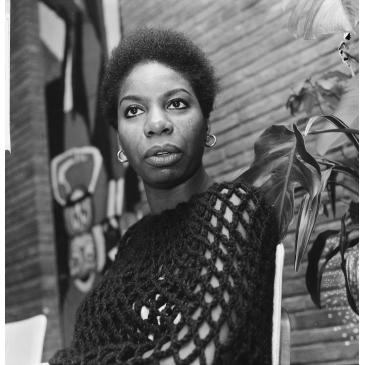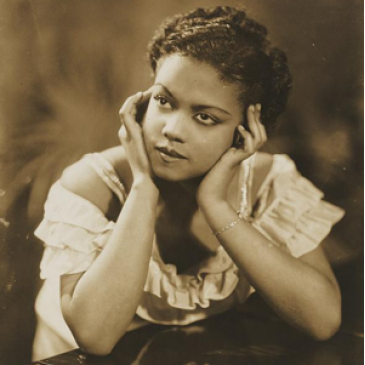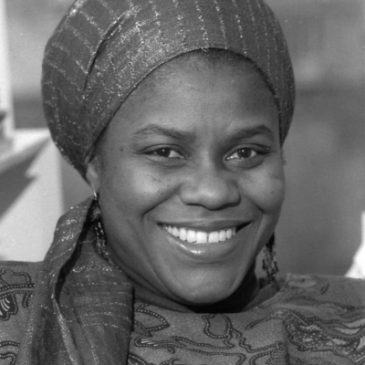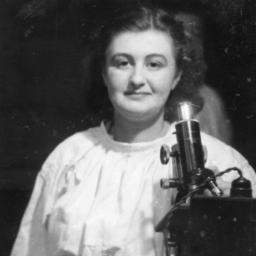Sister Rosetta Tharpe
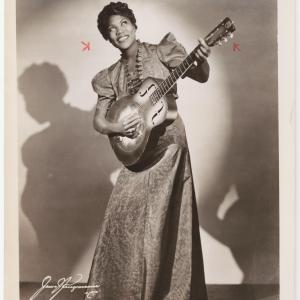
Tharpe began her musical pursuits in the church. She experimented with various genres including rhythm and blues and rock and roll
She was exceedingly skilled at playing the electric guitar, asserting her mastery as a woman guitarist
Tharpe has been dubbed the “Godmother of Rock and Roll”. Musicians such as Elvis Presley, Chuck Berry, Eric Clapton and Little Richard have cited her as an influence
“Can’t no man play like me. I play better than a man.” Sister Rosetta Tharpe, n.d.
Early Life
Sister Rosetta Tharpe was born Rosie Etta Atkins in 1915 in Cotton Plant, Arkansas. Both of Tharpe’s parents, Katie Bell Nubin and Willis Atkins, were singers. Katie Bell also played the mandolin. Tharpe’s father was not involved in her life; even so, her mother’s influence alone set Tharpe on the path of becoming a performer. Alongside her work as a cotton picker, Katie Bell was also a deaconess-missionary and a women's speaker for the Church of God in Christ. This made the church “radical for its encouragement of rhythmic musical experimentation …, as well as allowing women, such as Sister Rosetta’s mother, Katie Bell Nubin, to preach and sing in church,” (Mazique 2019). Though Tharpe was shy, her involvement in the church gave her the opportunity to both sing and play guitar for audiences from as early as age four.
In 1921, Tharpe and her mother moved to the South Side of Chicago for a change of scenery. Once she turned six, the mother-daughter duo began to tour with an evangelist troupe that performed throughout various locations in the South. As she grew older, Tharpe recognized that the more attention her performances garnered, the more of a chance she had to spread her talent, particularly in her favorite genres: gospel, jazz, and blues. While still involved with the Church of God in Christ, she soon realized that Christian ideals denounced jazz and blues. Though the church was often progressive, she was still taught to look down at genres such as rhythm and blues. Tharpe quickly found common ground between religion and song in her ongoing commitment to regularly perform at church conventions (Wald 2018). Tharpe and her mother continued to perform together throughout the 1930s.
As her talent garnered her more attention, Tharpe desired a life that provided a level of celebrity fitting of her talent. Though she did not feel that fame was in direct contradiction to her faith, there were many external conflicting opinions. Dabbling in jazz and blues was frowned upon by some in the Christian community, as many felt it was inappropriate and unbecoming of a Christian woman Tharpe’s exploration of these genres quickly became strained due to its impact on her relationship with her mother, Katie Bell, who shared similar opinions about jazz and rhythm and blues as other Christian’s in their community.
In 1935 at age 19, Tharpe married a Church of God in Christ preacher named Thomas Tharpe. Though her marriage with Thomas would not last, her time in church with him was where she donned her namesake: Sister Rosetta Tharpe. The pair performed radio shows where Thomas preached and Tharpe performed, which only increased the guitarist’s popularity (Wald 2022). By 1938, the couple was divorced and Tharpe was living in New York City. She then married promoter, Foch P. Allen in the early 1940s, though the two ultimately split (Wald 2012).
Road to Stardom
Upon her move to the musical metropolis that was New York City, opportunities abounded. Her newfound fame brought opportunities to perform at both the Cotton Club and the Apollo Theater in 1983. Notably, Tharpe was the first gospel soloist to play a gig at the Apollo (Wald 2004). In 1941, Tharpe began to produce her first recorded performances. She was signed to perform with swing band Lucky Millinder Orchestra. The orchestra was known for “churning out danceable pop hits,” (Wald 2004). She toured with Millinder until 1943, recording various hits such as “The Lonesome Road,” “Down By the Riverside,” “Four or Five Times,” “Shout Sister Shout,” and “(I Want a) Tall Skinny Papa,” (Wald 2004, Britannica 2024).
Though many of her songs still maintained gospel undertones, Tharpe began to face overt backlash from religious groups regarding her music. Tharpe’s formative musical experiences in the church undoubtedly impacted her musical stylings, particularly considering that the Church of God in Christ was noted for its “robust and lively musical expressions of faith,” (Wald 2004). Though Tharpe’s performances were undoubtedly high-spirited, the mixed-genre elements made some religious listeners call Tharpe a secular artist. Tharpe’s critics also scrutinized her frequenting of nightclubs and performances that featured scantily clad background dancers (Popmatters 2007). Many also called Tharpe’s masterful guitar playing into question, with naysayers implying that she had strayed too far from traditional gender roles.
Amidst critiques of her music, Tharpe was also subject to the confines of socio-political conflicts. As described by the Jim Crow Museum: “Jim Crow was the name of the racial caste system which operated primarily, but not exclusively in southern and border states, between 1877 and the mid-1960s,” (Pilgrim 2000). Still in place in the 1940s, Jim Crow Laws mandated that racial segregation between communities of color and white communities were in place. As such, even as Tharpe performed along white artists (such as the Jordanaires), she was required to sleep on buses and eat her meals outside of restaurants (Diaz-Hurtado 2017). Eventually, Tharpe would come to purchase her own tour bus to “[combat] the exclusions and indiginities of segregation,” (Wald 2018).
Even so, others remained staunch fans of Sister Rosetta Tharpe and found her prowess as a guitarist impressive rather than appalling. Her unique style combined elements of “Delta blues, New Orleans jazz and gospel music,” (Diaz-Hurtado 2017). Though a lack of acceptance from the community that raised her was emotionally challenging for Tharpe, other audiences took feverishly to her music . She rose to the very top with no signs of stopping, becoming a national sensation. Lifelong friend, Roxie Moore, spoke emphatically to Tharpe’s talent: "She could play a guitar like nobody else you've ever seen ... People would flock to see her. Everybody loved her,” (Rose 2009).
Spirituality vs. Identity
By 1946, Tharpe was a seasoned performer. Not only did she ooze talent, but she could also be counted on to know talent when she saw it in others, including in gospel singer Marie Knight. While attending a concert at the Golden Gate Ballroom in Harlem, Tharpe heard Knight perform for the first time alongside singer Mahalia Jackson and took great interest in her (Grimes 2009). A few weeks later, she extended an offer to Knight to develop a musical act and tour as a duo. Soon after agreeing, Knight became not only Tharpe’s partner in performance, but in life. The two produced a hit song entitled “Up Above My Head,” (Diaz-Hurtado 2017). They also teamed up on tracks “Precious Memories,” “Didn’t It Rain” and “Beams of Heaven”. Each of these call-and-response songs solidified Tharpe and Knight as “one of top gospel acts of the era,” (Grimes 2009). The women made their mark by breaking through to the rhythm and blues charts which was not typical of the time (Grimes 2009).
While Tharpe’s queer identity has not been researched at length, it has been noted that she had relationships with both men and women throughout her life (Wald 2022). Additionally, the women were in a committed relationship and supported by other musical artists of the time. The prominence of this partnership both on a personal and professional level cannot be understated: “[Tharpe and Knight] toured, collaborated and performed as two queer black women in a relationship in the late 1940s; it was a radical act,” (Diaz-Hurtado 2017). The pairing was wildly beneficial overall, though the women would not last as professional nor romantic partners. Tragedy struck in 1940 when Knight’s two children passed away due to a house fire (Grimes 2009). Though a tragedy that brought the women closer, the pair would eventually split in 1950. Tharpe and Knight remained close friends.
The 1940s presented a variety of obstacles for queer people - especially regarding being out. Tharpe biographer, Gayle Wald, shared with Out in The City that:
“Do I think Sister Rosetta Tharpe had attractions to and sexual relations with women? Yes…But I don’t know if she used any words to identify herself. …In the gospel world, it it was understood that people protected each other’s privacy. You didn’t want to ruin anyone’s career or life. … That way, people lived their lives as openly as they could,” (Wald 2022).
Between a mix of her religious beliefs, her fame, and racial and gendered constraints at the time, these elements impacted how freely Tharpe was able to live. As such, her continued meshing and bending of genres that laid the foundation for rock and roll allowed her to express herself in ways that were not typical of the time. Music remained a constant - providing her with a reprieve when battling oppressive circumstances.
Later Life and Legacy
Two years later, in 1951, Tharpe found companionship with her manager, Russell Morrison. The two set out to get married, with her third and final wedding (that also doubled as a concert) attracting 25,000 fans. Remaining close, Marie Knight was one of Tharpe’s bridesmaids. Though Morrison and Tharpe’s relationship was complex, the two would remain together until her passing in 1973. Twenty years of continued fame meant more milestones – Sister Rosetta Tharpe recorded what is said to be the first interracial duet in the U.S. with singer Red Foley, “Have a Little talk with Jesus.” She also recorded various albums with others, featured on various tracks and toured across the U.S. and Europe. Her discography grew during this time, with notable LPs Precious Memories and Singing in My Soul both produced in 1968. The latter of the two was nominated for an Emmy for Best Soul Gospel Performance.
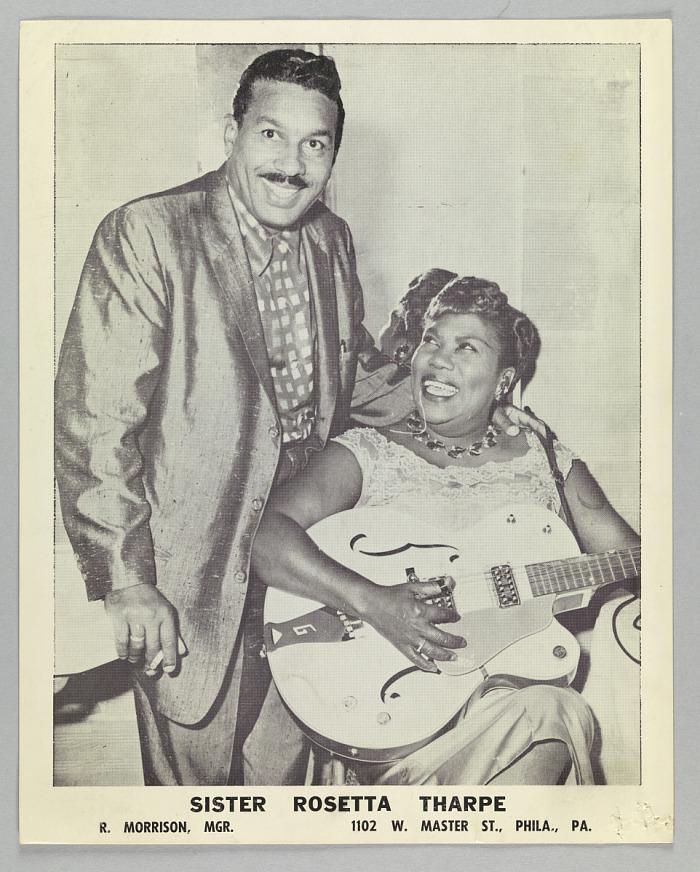
As the years passed, performances began to dwindle. As Tharpe lost listeners throughout the 1960s as younger audiences shifted their musical tastes to different genres, she pivoted. She moved to England and began to perform in London and Liverpool (Openshaw 2022). In 1957, when interviewed by London’s Daily Mirror, Tharpe proclaimed “All this new stuff they call Rock and Roll, why I’ve been playing that for years now,” (Wald 2018). Years later, in 1970, Tharpe had a stroke and began to struggle from diabetes. Between 1970 and 1973, one of her legs was amputated as a result of health complications. Tharpe passed away on October 9th, 1973, in Philadelphia, Pennsylvania from another stroke (Popmatters 2007). She was 58 years old.
Since her passing, Tharpe’s legacy remains at the center of much discussion. Artists such as Elvis Presley, Eric Clapton, Little Richard and Chuck Berry have cited her as a major influence. “In response to his 1986 induction in the Rock and Roll Hall of Fame, Chuck Berry was quoted saying “My whole career has been one long Sister Rosetta Tharpe impersonation,” (Leigh 2024). A 32-cent stamp honoring Tharpe was produced by the US Postal Service in 1998. In 2007, Tharpe was inducted into the Blues Hall of Fame (Openshaw 2022). Later, January 11th was officially designated Sister Rosetta Tharpe Day in Pennsylvania given how much time Tharpe spent there (Openshaw 2022). In light of discourse surrounding her heavy influence on rock and roll, she was inducted into the Rock and Roll Hall of Fame in 2017. Media inspired by her life has also been produced, including the 2023 musical entitled Shout, Sister, Shout!, which premiered in 2019 at the Seattle Repertory Theatre.
The Godmother of Rock and Roll led a complicated, though fruitful life. Her relationship to religion, Blackness, queerness, and womanhood within the early to mid-1900s brought strife but also brought her joy and beauty – all of which manifested within her musical musings and the soulful strumming of her guitar.
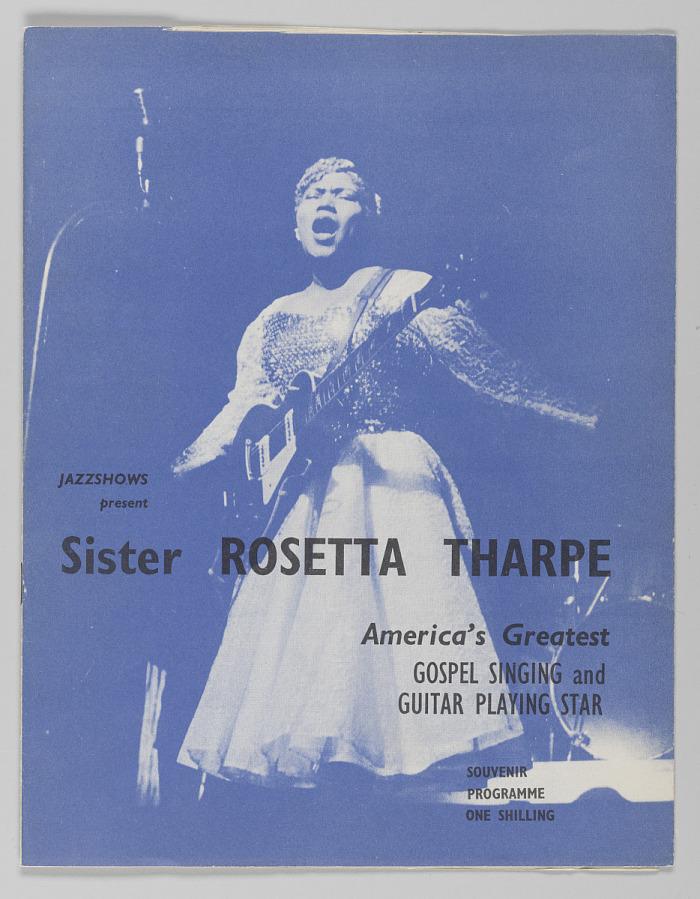
 Primary Source Analysis Strategies
Primary Source Analysis Strategies
Primary Source Analysis
“Shout Sister Shout” recording
Caption: Sister Rosetta Tharpe performs “Shout Sister Shout” alongside Lucky Millinder and his Orchestra circa 1941.
Analysis Questions:
-
After viewing this video, what do you notice about Tharpe’s performance or musical style that you did not expect?
-
What questions does this live performance raise for you?
-
Who do you think was in the audience for this performance? Why?
“Up Above My Head” recording
Caption: An audio recording of Tharpe and Knight singing “Up Above My Head,” one of the duo’s hit tracks.
Analysis Questions:
-
Think about the first song that you heard earlier in the first video featured in the biography. What differences do you notice between the performances? What similarities?
-
Why do you think that this song was a hit amongst fans of Tharpe and Knight? What musical elements stand out?
Caption: This 1950s photo depicts Sister Rosetta Tharpe alongside manager and husband, Russell Morrison. His arm is around her while she looks up at him with a smile.
Analysis Questions:
-
Why do you think this photo was taken?
-
When examining the pair in this image, what questions come to mind for you about them?
Caption: The object pictured is a souvenir program from a Sister Rosetta Tharpe concert series in England. She is seen with her arms outstretched and guitar across her chest as she sings.
Analysis Questions:
-
Examine Tharpe’s appearance in this image (her hair, her clothes, her demeanor). What are you drawn to? Why?
-
Reflect on Tharpe’s musical journey that you have learned about in this resource. Why is this image - as well as the tagline on the cover - significant?
Educator Notes
This resource outlines different lenses that students can examine through primary resources. There is no specific order to use the columns in. The questions students develop through their examination are meant to encourage further research and curiosity. Educators can then propose other activities (as outlined in the resource) that help students further contextualize different - but related - primary sources.
This is a blank version of the previous link. Educators can create their own specific sample questions (most likely based on the medium of the primary source to have students answer in each column), or simply have students fill out this document with the guidance of the original document.
Citation for main image: Personal Management Gale Agency. Unknown. Sister Rosetta Tharpe with guitar. black-and-white photographs. Place: Collection Title Proper: Amsterdam News Photograph Archive, Repository: Division of Rare and Manuscript Collections, Cornell
MLA – Dawson, Shay. "Sister Rosetta Tharpe." National Women's History Museum. National Women's History Museum, 2024. Date accessed.
Chicago - Dawson, Shay. “Sister Rosetta Tharpe" National Women's History Museum. 2024.
Citation for main image: Personal Management Gale Agency. Unknown. Sister Rosetta Tharpe with guitar. black-and-white photographs. Place: Collection Title Proper: Amsterdam News Photograph Archive, Repository: Division of Rare and Manuscript Collections, Cornell
MLA – Dawson, Shay. "Sister Rosetta Tharpe." National Women's History Museum. National Women's History Museum, 2024. Date accessed.
Chicago - Dawson, Shay. “Sister Rosetta Tharpe" National Women's History Museum. 2024.
Gayle F. Wald. Shout, Sister, Shout! The Untold Story of Rock-and-Roll Trailblazer Sister Rosetta Tharpe. Boston, MA: Beacon Press, 2007. ML420.T395 W35 2007

This biography is sponsored in part by the Library of Congress Teaching with Primary Sources Eastern Region Program, coordinated by Waynesburg University. Content created and featured in partnership with the TPS program does not indicate an endorsement by the Library of Congress.
For further information or questions, please contact history@womenshistory.org.

